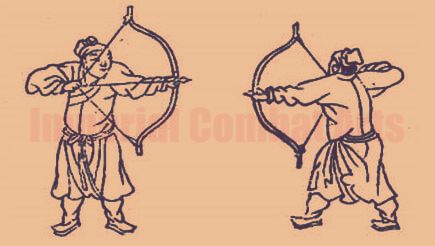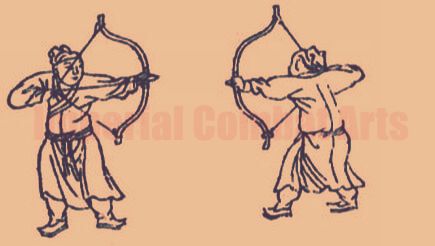NEW BOOK OF DISCIPLINE AND EFFECTIVENESS
CHAPTER THIRTEEN - ARCHERY
Written by Ch'i Chi Kuang (Qi Ji-Guang) 1500's C.E.
©Translated to English by Marek Aquila 2020
©Translated to English by Marek Aquila 2020
|
According to ‘The Biography of Brilliant Women’, you should "draw a bow in a state of tension and release it in a relaxed state." "Tension" means fully engaging with all your abilities, and "relaxation" means that your mind should be calm and focused.
“The draw-weight of the bow corresponds to the strength of the archer, and the spine of the arrow corresponds to the weight of the bow.” This is the most important thing. That's why, citing 'Xun Zi', “If the arrow spine is not correct for the bow, even Yi couldn't score a hit with it.” In Mencius, it says, "When Yi taught archery, he insisted that (students) fully drew their bow." Our students must also fully draw their bows. The archer's most important skill is "Grasping the bow, concentration, and solid form." "Concentration" is minute attention to your shooting; solid form" means to maintain a firm grip on the bow. The string that slaps the sleeve is always caused by the lack of stability of the bow's grip. Arrows that are porpoising and lack of force are always due to the arrowhead not touching the finger. (the arrowhead “touching the finger” would indicate a full draw if the arrow is the proper length for the archers draw and bow.) The manual [of Wang Ju] says, “Without the arrowhead being drawn back and felt by the finger it is just like being blind, and one cannot hit a target. The "finger" here represents the end joint of the bow hands middle finger. ‘The finger feeling the arrowhead’ refers to the way you feel the arrowhead touch your finger - without using your eyes. Full draw cannot be achieved unless the arrow is felt at the end of the finger. You have to do it with every arrow before you can really talk about shooting. "Concentration" is mental focus throughout the full draw and the release of the arrow. Modern archers pull back two-thirds of their arrow before they begin the process of concentration. What good does that do them? As for "focus", many people think it's just focusing on the target. They don't realize that focusing on the target is secondary to the problem of focusing on how you're going to hit it. The key is that, at the moment when you reach a full draw, your attention is stretched to full, and your arms and legs are no longer tense. If your release is not pre-planned, then whether the arrow will go straight and whether it hits is not determined by your conscious mind. You must deepen this concentration, keep your mind open, and your arms and legs firm but relaxed. After that, the arrow is released, and there is no reason it will not fly straight, and hit the target. The word "concentration" in the manual [of Wang Ju] is the same as the word “meditation'' in the book "The Great Learning": He meditated on it, and then he was able to achieve it. When a gentleman tries to perfect himself completely, he knows when he should reach that stage of perfection and is determined to reach it, and then become calm, and then be at peace. He must be able to ponder these qualities in order to fully achieve his goals. When a gentleman practices archery, and he has fully drawn his bow, he must concentrate on shooting before releasing the arrow, and then he has a guarantee of hitting the target. You need to know what's behind the concept of "focus" and relate it to the concept of "meditation" (in the "Great Learning"), fully integrate it, and then you will succeed. You grab the bow and put your thumb on your middle finger: this is the greatest old shooting technique. You must not fail to use it! In horseback archery, always draw to at least ninety percent of a full draw before you release: Never forget! When the bow is only 70 percent or 80 percent, it's hard to hit. When it comes to horse archery, you should always pull two arrows at a time (from your quiver), one of which will be held by the bow hand, while nocking the other on the bowstring, so that it is convenient. Putting an arrow in your collar or belt: neither is convenient. Always do as I say! Whenever your arrow goes off course, it's best to have it go high and over the target. Don't let it go low, and not reach. Everyone has made this mistake. Don’t forget! You must keep calm when you are shooting in the examination grounds. The thought of missing must never enter your mind. Carry on as if no examining officer is watching you, just like you would in your daily practice: one arrow - beautiful and slow - feel the arrowhead with your finger - the next arrow - focus with each arrow - the next arrow: how can you fail to hit? To give assurance that you will hit, always be at ease and do things in your own time. Such assurances can only come from the absence of nervousness or haste. If you are sloppy or nervous and you are still hitting, this is just a lucky shot. If you haven't scored after the first five shots, you should stay relaxed and stay focused. You mustn't let your actions become rushed just because you haven't scored. If you're in a hurry, then shots six to nine will also miss. Wang Ju's horse-riding archery manual says, "It's as powerful as chasing the wind, The eyes move like lightning, Draw the bow fully, release the arrow immediately, The eyes are fixed and unblinking, Your body is as solid as a rock, Don't lose your momentum' Lift the bow like "The moon rises from your chest". Place the arrow on the string like ‘placing scales on the string’. Your breath should be coordinated with the actions you perform in your mind. So the Manual [of Wang Ju] says: "Don't worry about the bow's draw-weight being too light: get used to it, then you'll still get good distance from it. If you're worried that the bow's draw-weight is weak: draw it, and it will naturally fire crisp. But to gain enough strength to draw your bow, you must draw it fully. Starting with a short shot and then going farther away is not easy. Basically, you still have to learn to pull the bow back to the full draw and be able to cover the long distance, and then you come back and start working with your precision. It's not as if someone who’s never drawn a bow, will just limit themselves to twenty to thirty steps. It would just be holding oneself back. How can you reach any distance? Whether you are shooting at an enemy or a target, you must take a firm stance and keep your attention on your target or your enemy: don't look at the arrow while you nock it. If you blink, you may not be able to dodge in time, someone will get the better of you! Whenever you shoot, your front legs position should be as if you're stepping on something, and the hind leg should bow. Any movement that follows the aim of the arrow can only be with the rear foot. The shoulder of the bow arm and the forward hip should be directly opposite the toes of the right foot, "not quite right angles, and not exactly in a 'V'”. If you are shooting to the right, move to your left foot, and if you shoot to the left, shift to your right foot: these two phrases express the trick of hitting the target directly. This covers the positions of the feet. Then you push your bow-hand forward, as if pushing Tai Mountain away; and your string hand is like pulling on a tiger's tail. To keep control, keep the front and back fists level and straight, slowly draw the bow, and then release with your hands keep in tension. If the target is large (close), lower your bow hand to the small area of the target you are aiming at. If the target is small (far away), raise your hand and aim at the entire target. “Lowering" the hand means to lower the bow hand, and "raising" means to lift the bow hand. These two phrases are the basis of archery. The bow hand "pushes" and the string hand "pulls": this is the trick of coordination. Apply the strain evenly [in both arms], extending the arms and shoulders. If this is done correctly, the arrow will go very fast and will reach twice as far as normal. This concludes the technique of the hands.. "Putting your cheek next to the string, the neck arched back, the chest pushed forward, the spine arching back, these are the errors of form. That wraps up form. If the arrow does not fly straight, the problem arises from the thumb of the draw hand hooking the string too tight. This in turn is caused by the opening and relaxation of the ring finger and little finger. This is a beginner's mistake. When shooting, try pressing about an inch of straw between the ring finger/little finger and the bottom of the palm of your hand. When you release, the straw doesn't fall, and the arrows fly straight. When you open fire in the face of an enemy, as long as you keep courage, keep the level of your strength stable, keep your potential energy high and restrained on a short leash, then every shot will hit home and no one can escape you. To do this, you need to keep all your movements below maximum: draw, but don't pull the bow to the full extent of your strength; and ensure every shot counts. Only with your arms straight and even you can take a firm stance: this will naturally make your potential energy high. You need to wait until the enemy is within a few dozen steps, so you can hit them with one shot, and ensure a kill. If you're worried about the enemy being close and their blades are nearly upon you: this way each shot will be worth ten-fold. When you're dealing with the enemy cavalry, shoot the biggest target on the battlefield: don't just shoot at people. The famous poem is: "When you draw a bow, draw a bow that is powerful, When you fire an arrow, fire one that is long! Before you shoot a rider, shoot a horse. Kill the leader first, and you take the rebel force!” Always pay attention to the proper feeding of your horse and its seasonal requirements. Train her to move at the right pace, obey moving and stopping, not to panic when she encounters obstacles, and not to cut corners at the gallop. The front legs should move forward together from the level of the ears, and the hind legs need to move forward coordinated with the front legs. This allows the movement to be fast and stable, allowing the rider to use his weapon. A man's life depends on his horse. Horses of the steppe are more accustomed to war than Chinese horses. This is the result of regular training. FIRM GRIP STYLEAccording to this style, when the bow is fully drawn, the left forearm is as straight as the bow string and the bow is tilted like the moon. The bow arm is level with the nipple.
FLAT PALM STYLEAccording to this style, when the bow is fully drawn, the outside of the elbow points down, the elbow itself is straight, like the arms of a balance. The bow must be held at eighty percent of a horizontal position.
ADDITIONAL ARCHERY TEXTS |


